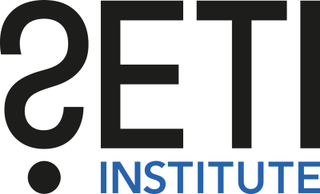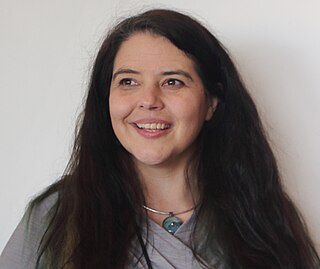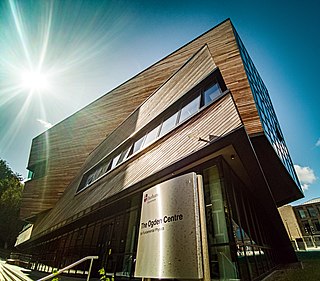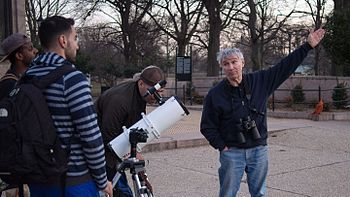
The Space Telescope Science Institute (STScI) is the science operations center for the Hubble Space Telescope (HST), science operations and mission operations center for the James Webb Space Telescope (JWST), and science operations center for the Nancy Grace Roman Space Telescope. STScI was established in 1981 as a community-based science center that is operated for NASA by the Association of Universities for Research in Astronomy (AURA). STScI's offices are located on the Johns Hopkins University Homewood Campus and in the Rotunda building in Baltimore, Maryland.

The SETI Institute is a not-for-profit research organization incorporated in 1984 whose mission is to explore, understand, and explain the origin and nature of life in the universe, and to use this knowledge to inspire and guide present and future generations, sharing knowledge with the public, the press, and the government. SETI stands for the "search for extraterrestrial intelligence".

The Astronomical Society of the Pacific (ASP) is an American scientific and educational organization, founded in San Francisco on February 7, 1889. Its name derives from its origins on the Pacific Coast, but today it has members all over the country and the world. It has the legal status of a nonprofit organization.

Armagh Planetarium is a planetarium located in Armagh, Northern Ireland close to the city centre and neighbouring Armagh Observatory in approximately fourteen acres of landscaped grounds known as the Armagh Astropark.

The International Year of Astronomy (IYA2009) was a year-long celebration of astronomy that took place in 2009 to coincide with the 400th anniversary of the first recorded astronomical observations with a telescope by Galileo Galilei and the publication of Johannes Kepler's Astronomia nova in the 17th century. The Year was declared by the 62nd General Assembly of the United Nations. A global scheme, laid out by the International Astronomical Union (IAU), was also endorsed by UNESCO, the UN body responsible for educational, scientific, and cultural matters.

The Space Science Institute (SSI) in Boulder, Colorado, is a nonprofit, public-benefit corporation formed in 1992. Its purpose is to create and maintain an environment where scientific research and education programs can flourish in an integrated fashion. SSI is among the four non-profit institutes in the US cited in a 2007 report by Nature, including Southwest Research Institute, Planetary Science Institute, and Eureka Scientific, which manage federal grants for non-tenure-track astronomers.
Science outreach, also called Education and Public Outreach or simply public outreach, is an umbrella term for a variety of activities by research institutes, universities, and institutions such as science museums, aimed at promoting public awareness of science and making informal contributions to science education.

Heidi B. Hammel is a planetary astronomer who has extensively studied Neptune and Uranus. She was part of the team imaging Neptune from Voyager 2 in 1989. She led the team using the Hubble Space Telescope to view Shoemaker-Levy 9's impact with Jupiter in 1994. She has used the Hubble Space Telescope and the Keck Telescope to study Uranus and Neptune, discovering new information about dark spots, planetary storms and Uranus' rings. In 2002, she was selected as an interdisciplinary scientist for the James Webb Space Telescope.

Pamela L. Gay is an American astronomer, educator, podcaster, and writer, best known for her work in astronomical podcasting and citizen science astronomy projects. She is a senior education and communication specialist and senior scientist for the Planetary Science Institute. Her research interests include analysis of astronomy data, as well as examination of the impact of citizen science initiatives. Gay has also appeared as herself in various television documentary series.

IRrelevant Astronomy is a web series produced by NASA's Spitzer Space Telescope. Each episode explains a general science concept or reveals science news relevant to Spitzer. The "IR" in the title stands for "infrared", making the title refer to "infrared-relevant astronomy." The first episode launched on January 15, 2008 on the Spitzer Space Telescope website.

National Astronomical Research Institute of Thailand or NARIT is a research institute under the Ministry of Higher Education, Science, Research and Innovation. Its main missions are to carry out, support, and promote the development of astronomy and astrophysics in Thailand through research, public outreach, and educational activities.
A mobile museum is a museum educational outreach program that bring the museum to the people rather than vice versa. Typically they can be in Recreational Vehicles (RVs) or trucks/trailers that drive to schools, libraries and rural events. Their business model is to use grant or donor support, as they goal is to make the museum exhibit accessible to underserved populations. Below are some examples of mobile museums.

The Institute for Computational Cosmology (ICC) is a Research Institute at Durham University, England. It was founded in November 2002 as part of the Ogden Centre for Fundamental Physics, which also includes the Institute for Particle Physics Phenomenology (IPPP). The ICC's primary mission is to advance fundamental knowledge in cosmology. Topics of active research include: the nature of dark matter and dark energy, the evolution of cosmic structure, the formation of galaxies, and the determination of fundamental parameters.
Physics outreach encompasses facets of science outreach and physics education, and a variety of activities by schools, research institutes, universities, clubs and institutions such as science museums aimed at broadening the audience for and awareness and understanding of physics. While the general public may sometimes be the focus of such activities, physics outreach often centers on developing and providing resources and making presentations to students, educators in other disciplines, and in some cases researchers within different areas of physics.

The ESO Supernova Planetarium & Visitor Centre is an astronomy centre located at the site of the European Southern Observatory (ESO) Headquarters in Garching bei München. It offers exhibitions, guided tours and planetarium shows that feature observations made by the telescopes of the European Southern Observatory.
Aomawa L. Shields is an associate professor of physics and astronomy at UC Irvine. Her research is focused on exploring the climate and habitability of small exoplanets, using data from observatories including NASA's Kepler spacecraft. Shields was a 2015 TED Fellow, and is active in science communication and outreach. She develops interactive workshops to encourage self-esteem and teach about astronomy, combines her training in theater and her career in astronomy.
The Dunlap Institute for Astronomy and Astrophysics at the University of Toronto is an astronomical research centre.

Kimberly Kowal Arcand is a data visualizer and science communicator for NASA's Chandra X-ray Observatory. She is also the visualization coordinator for the Aesthetics and Astronomy image response project at the Center for Astrophysics | Harvard & Smithsonian located in Cambridge, Massachusetts.
Nancy Cottrell Maryboy is a Cherokee and Navajo Indigenous science expert and educator. Maryboy is the president of the Indigenous Education Institute, an organization she founded in 1995 to apply traditional Indigenous knowledge to contemporary settings. Much of her work has focused on Indigenous astronomy and she has written several books on Navajo astronomy.













